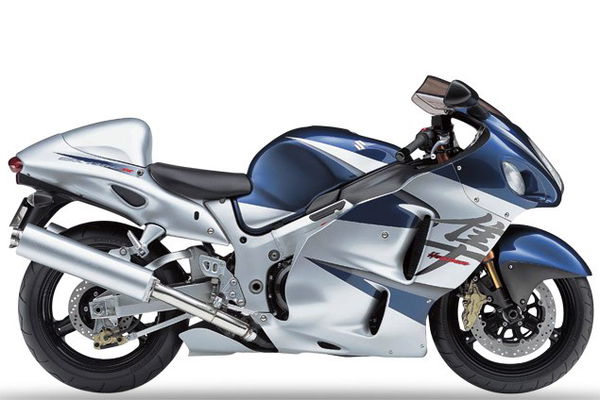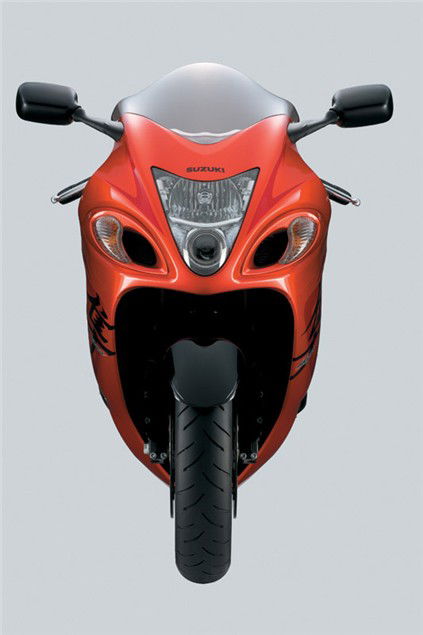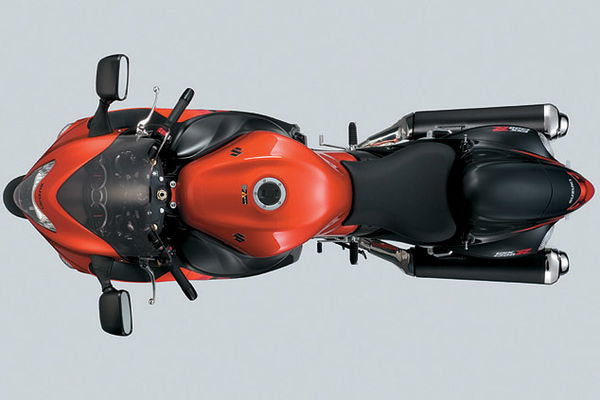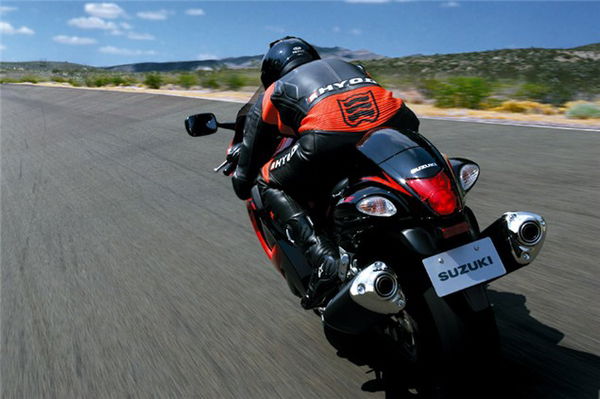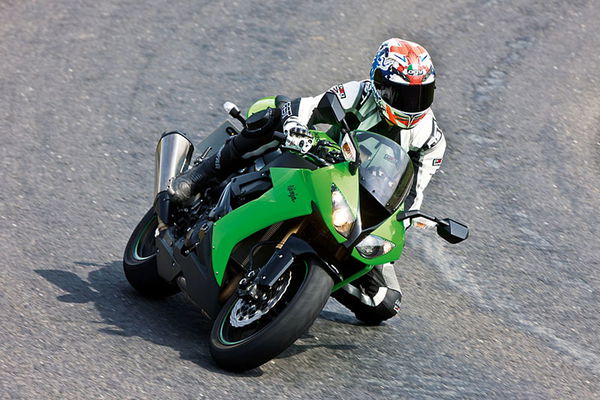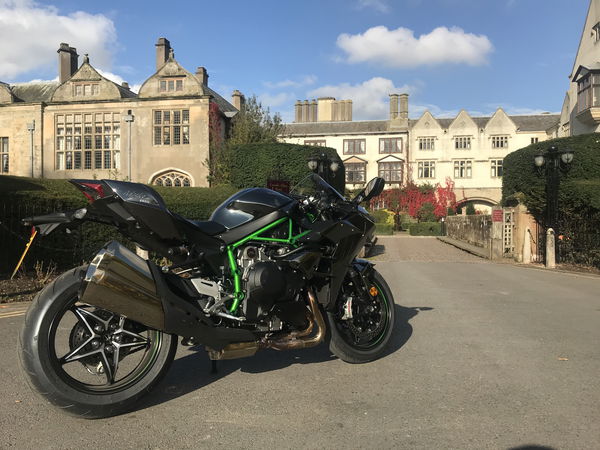Buyer Guide: Suzuki GSX1300R Hayabusa
The ultimate buyers guide to Suzuki’s warpship Hayabusa, written by the people who own the bike...
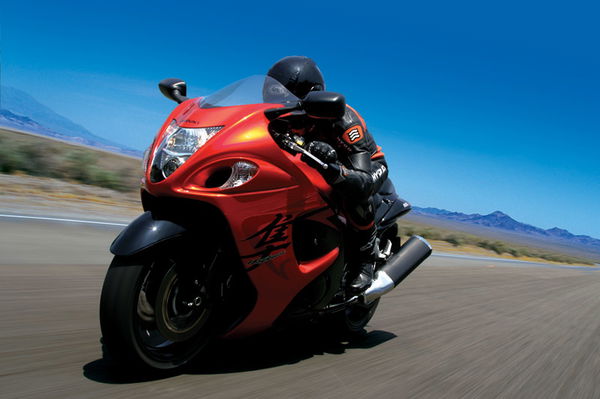

Click to view: Suzuki GSX1300R Hayabusa owners reviews, specs and image galleries.
Nothing looks like a Hayabusa and not much goes like one either. Those wierd, bulbous looks come from wind tunnel testing with a rider on board and hint what this bike’s all about: speed.
The original Hayabusa was the fastest, most powerful bike you could buy when it was released. The new 2008 model regains the power crown.
While rivals may come close on peak power, what sets the Busa apart is its colossal midrange. Most competitors like the ZZR1400, ZX-12R and Blackbird need a few revs on the clock before they really hitch their skirts up and get a wiggle on. Not the Busa. Even with just 3,000rpm on the tacho it’s kicking arse and taking heads. This makes it devastatingly quick even when the rider’s relaxed and not trying. Want to overtake? You already have. Go further round the rev counter and things get even better culminating in an insane rush for the red line.
So it’s ridiculously fast. But incredibly, it’s also a very useable, practical bike too. It’ll commute, run errands, tour and even scratch although it’s a fraction on the porky side to mix it with well ridden sportsbikes on track days. What’s more it’s reliable and not too expensive to run – although insurance isn’t cheap and you’ll get through tyres.
It’s much loved by the drag racing crowd but it’s also popular in the hip-hop world where Busas get lavished with shiny custom parts, outrageous paint jobs, tuning and a whole lot of ass belonging to some fine Caribbean queens – but bear in mind that image works better in California than Croydon.
The bikes hold their value well on the used market and most don’t get abused as owners tend to be a little older and more sensible than sporty 600s.
With the new for 2008 K8 model appearing on the used market, prices of the original bike have dropped a little recently and you can get a tidy one for around £3,000. Never has so much been available to so many for so little.
Suzuki GSX1300R Hayabusa Specifications
1999 Suzuki GSX1300R Hayabusa
Engine l/c, 16v, injected inline four, 1,298cc Power 175bhp @ 9,800rpm Torque 99ftlb @ 7,000rpm
Dry weight 215kg Seat height 805mm Fuel capacity 21 litres Top speed 186mph (restricted)
2007 Suzuki GSX1300R K8 Hayabusa
Engine l/c, 16v, injected inline four, 1,340cc Power 194bhp @ 9,500rpm Torque 115ftlb @ 7,200rpm
Dry weight 220kg Seat height 805mm Fuel capacity 21 litres Top speed 186mph (restricted)
Tyres
The most liked tyres in the survey were Michelin Pilot Power 2CTs. They’re a good fast road tyre which should cope with anything but last well too thanks to their dual compound construction. Michelin Pilot Road II are the next most popular. They’re similar to the Powers but are more road and less track orientated.
Avon Storm STs are similar, come joint third and British riders rate them highly for performance in all weathers and longevity as well (typically getting 4,000 miles from a rear). Joint third is the Bridgestone BT56SS-J. They’re specifically made for the Busa and OE fitment. They grip well but they’re an older design and don’t last as long as the latest rubber.
Loads of other tyres are fitted including sporty rubber like Bridgestone BT-015 and 016s, Metzeler Sportec M1 and M3, Pirelli Diablo Corsa IIIs and Dunlop Qualifiers. Tyre life is excellent considering the bike’s power. Average life for a front is 5,971 and rear 3,909. Buddy Wackit (no we’re not making this up) gets 12,000 from a front and 6,000 from a rear Metzeler M3 Sportec although those are American miles which are shorter than UK imperial ones.
- Top tyres
Michelin Pilot Power 2CT 15%
Michelin Pilot Road II 9%
Avon Storm ST 6%
Bridgestone BT56SSJ 6%
Consumables and expenses
Considering the colossal performance the Hayabusa’s running costs are surprisingly low. Average fuel consumption is 41mpg but 60+ is possible if you’re gentle on the throttle. Equally so’s 28mpg (stand up and take a bow Thomas Dobberthein) if you ride the bike hard enough. Average miles per tank is a useful 167 but Chris Deaves once managed to eek 270 miles from a single filling – that’d be about 59mpg if he ran it from brim full to bone dry – a feat that’s rarely possible so it’s more likely he was getting 65mpg.
Services are due every 3,500 or 4,000 miles. The schedule alternates minor, intermediate, minor, major with valve clearances. Average prices paid were £123 for the minor one, £231 for the intermediate and £449 for the major with valve clearances.
The brakes are one area which gets criticised as they can fade from repeated hard use (typically on race tracks). EBC HH pads are the most popular, beating OE into second place. The EBCs are well liked although some people find them noisy. Carbone Lorraine and Bendix ceramic are highly rated by those who fit them. Average chain life is 16,164 miles and there’s plenty of riders getting 20,000 or more miles.
Owner Case Study: "Mine went wrong – I still love it"
Jools Goodwin has had problems...
“I was always a Kawasaki man but when I first saw the Hayabusa I thought ‘wow’. I found a nearly new one with under 2,000 miles on the clock which someone had bought, scared themselves on and got rid of. I bought it.
“I absolutely adore it. It does everything I want and more. I’ve had lots of bikes in the past and I was in a back patch club so I rode plenty of other peoples’ too, but this is the best by far. I know lads who’ve had Busas and moved onto something else but they all look back on them fondly and say they miss the roll on power.
“It has had some niggles. Fifth gear failed. I was out on it one day and it started making a funny noise as I engaged fifth. It didn’t sound right and it got worse fast. I took it to a a bike shop. We both thought it’d be a selector problem but it wasn’t, fifth gear was almost completely stripped. He replaced it and re-built the gearbox and it was fine. He did me a good price but I think it’d cost about £800 normally.
More recently one of the bolts came out of the clutch assembly and shattered one of the clutch plates. As soon as it happened I could hear there was a problem so I stopped the bike and got recovered home.
“I’ve never heard of anyone else having these problems so I think I was just unlucky. And I still absolutely adore the bike anyway.”
What goes wrong
Not a lot. A massive 83% of the people who filled in our on-line survey reported no problems with their bikes. Of those who did have some sort of problem, each was different and there’s no pattern except three (out of 36) people having some sort of issue with the gearbox – one had fifth give up all together, another says changing from fifth to sixth is awkward and finally one had their selector fork bend. Anecdotal evidence suggests lower gears can cause trouble too but it’s mercifully rare.
We’ve heard of problems in the past when the whole rear subframe has broken. While this sounds worrying, Suzuki blamed non approved parts – namely exhausts and luggage and said the original exhaust system was structural. From 2001 onwards bikes had a revised subframe made from steel rather than aluminium which is much stronger. Many early bikes have had these retro fitted (check with a magnet).
Camchain tensioners on early bikes failed sometimes – improved replacements have pink dots on them so can be easily identified. Early bikes also suffered if the fuel filter became blocked as it caused the fuel pump to overheat but most have been sorted by now.
Overall it’s an incredibly reliable bike. Even the finish doesn’t get criticised by 71% of owners in our survey with the rest saying the paint and fasteners aren’t as durable as they’d like.
There were seven new model (K8) bikes in the survey and none of them had a single problem but that’s not surprising as they’re all less than a year old.
Modification
Some people find the front brakes aren’t up to the job. They’ll stop the bike fine once but repeated slowing down from high speed can cause fade. Making sure the pads are in good condition and the fluid’s fresh is the first way to beat this but a few owners have fitted larger master cylinders (Brembo) or wavy discs (Galfer).
Timing Retard Eliminators are popular plug in electronic gizmos. The bike is restricted in the lower gears and this device bypasses that. Some owners make other claims that it’ll do all sorts from improving the power delivery to unblocking drains and servicing the wife.
You’d think the standard bike’s fast enough but some people fit high flow air filters (K&N is most popular), performance exhausts (Akrapovic is number one), Power Commanders and larger rear sprockets for improved acceleration (43 teeth seems optimal but you’ll need a Speedo Healer or similar).
Higher bars are very popular with Helibars being the favourite. Pazo brake levers, aftermarket seats and higher screens are also widespread.
We got quite a few replies from American Busa owners and to be honest for all out modding, they put the Brits to shame. Several have nitrous oxide injection, some have hot cams and long swing arms, quite a few have lowered their bikes drag style and outrageous plating and painting are popular. The Brits are ahead on handling mods with posh shocks and fork re-builds and lightweight wheels (Dymag) being favoured by those in pursuit of better handling.
Hard luggage is not popular – although topboxes and hard panniers can be fitted (SW Motech do kits among others). If that’s what you’re after make sure your Busa has the steel subframe and standard exhausts.
Culture
It’s a bike with a real following. There are good websites dedicated to it, hayabusa-1300.co.uk and hayabusa.org, which are full of friendly folk and jam-packed with information. The machine’s popular with drag racers and the hip-hop scene. Both modify bikes in their own distinctive way which might not suit the average road rider so think before buying anything too non standard.
Your Reviews
We're still on the look out for reviews of the Busa propelled rocket, register and review your Hayabusa over here for the first generation Suzuki Hayabusa and likewise here for the revamped and current 2007 Hayabusa.
Owner Case Study: "I’ve done 54,000 miles on mine"
Kevin Askew bought his Busa in 1999...
“In all that time I haven’t had a single problem with it. It’s been fantastic. I’ve had lots of bikes before – a FireBlade, GSX-Rs, a Kawasaki 750 Turbo and others but this is the best by far. It’s got the right mix; the handling’s good, it’s very reliable, the engine’s fantastic and it’s even quite cheap to run. I don’t like really light bikes as they can be a bit flighty but the Busa’s about perfect.
“Not long after I got it I had the suspension all rebuilt by MH Racing. It was the best money I’ve ever spent. It made it 10mph faster everywhere. They re-valved and set the shock and forks for my weight and used quality oil. The shock cost about £150 but I had the forks anodised and nitrided too so they were about £700 all in. I’ve ridden it to the Algarve in Portugal six or seven times and it always copes brilliantly even through a 52 degree heatwave in Spain. I’ve drag raced it, toured, even taken it up dirt tracks in mountains in Europe.
“I’ve bought another one for drag racing. I go to the Run-Wot-You-Brungs at Santa Pod with some mates for fun. I’m never going to set the world on fire but it’s a good day out. My second bike is another early one with 30,000 miles on the clock. I stripped the engine down to get it bored out to 1,400cc with Wiseco pistons for more compression. Goes like the wind.”
